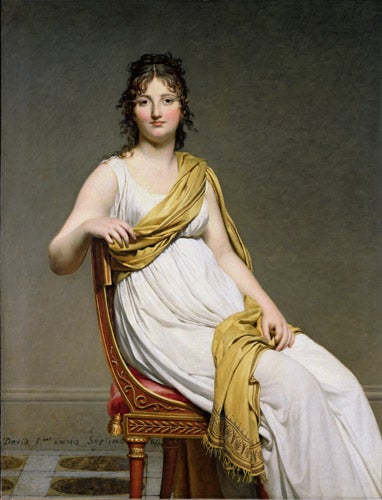Great Works: Henriette de Verninac (1799) Jacques-Louis David
Louvre, Paris

Your support helps us to tell the story
From reproductive rights to climate change to Big Tech, The Independent is on the ground when the story is developing. Whether it's investigating the financials of Elon Musk's pro-Trump PAC or producing our latest documentary, 'The A Word', which shines a light on the American women fighting for reproductive rights, we know how important it is to parse out the facts from the messaging.
At such a critical moment in US history, we need reporters on the ground. Your donation allows us to keep sending journalists to speak to both sides of the story.
The Independent is trusted by Americans across the entire political spectrum. And unlike many other quality news outlets, we choose not to lock Americans out of our reporting and analysis with paywalls. We believe quality journalism should be available to everyone, paid for by those who can afford it.
Your support makes all the difference.Statuary and sex are often linked. The story of Pygmalion is well known. A sculptor Pygmalion carves a woman in ivory so beautiful he cannot resist it. It? Her? He touches it, strokes it, kisses it, murmurs lovingly in its ear, kits it out with gowns and jewels, lays it down on a bed. (This is the version of the story given by the Roman poet, Ovid, in his long poem, Metamorphoses.) Finally, Pygmalion prays to Venus on her feast day, in her temple, begging that his statue should be his bride.
He goes home, and kisses it where it lies, "and she seemed warm;/ again he kissed her, and with marvelling touch/ caressed her breast; beneath his touch the flesh/ grew soft, its ivory hardness vanishing,/ and yielded to his hands..." (In A D Melville's translation.) It's not just that Pygmalion wants a living partner, rather than an artificial one. The process of coming to life, the transformation of ivory into flesh, is itself compared to sexual arousal and response.
This is a story about the love of statues where a statue comes alive. There is another where the statue stays stone. The Roman historian Pliny tells it. It's the story of the statue of Venus in the town of Cnidos, the masterwork of the sculptor Praxiteles. A young man, not the sculptor, became infatuated with this figure with the famous half-smile on its face. One night he broke into its sanctuary, and "embraced it tightly in his arms, warming the cold marble with his burning kisses, contaminating it with his lust, so that the stains ever after remained, as a monument to his impiety."
He didn't have Pygmalion's luck. But then, did he have Pygmalion's desires? He might have been seeking an inanimate partner. The stone of the Venus statue may have been part of what infatuated him. People who buy inflatable dolls, after all, aren't necessarily people who can do no better. They may be people who prefer it.
Any sexual arousal may involve, not only vitality, but inertia, passivity, objectification, playing thing. Even reading Ovid, with its happy ending, you may wonder at what point Pygmalion is really most excited. When the statue comes alive? Or when it doesn't? "With many a touch he tries it – is it flesh/ or ivory? Not ivory still, he's sure./ Kisses he gives and thinks they are received;/ he speaks to it, caresses it, believes/ the firm new flesh beneath his fingers yields..."
Neo-classicism understands this sexiness of statues, this statueness of sex. No painting understands it better than this portrait by Jacques-Louis David. The sitter, aged 17, is Henriette de Verninac, née Delacroix. (Her brother was the painter Eugène Delacroix, then aged one.) The date is the last year of the Directory period. Mme Verninac wears Directory fashion, classical costume, a chemise gown with a high waist and a low neck. She has natural hair, no jewels, a simple yellow wrap. Her setting is simple too, a blank background wall, a plainly tiled floor. A simple style – implying simple virtue?
David casts his young sitter as a Roman statue – or it might be better to say a Roman doll. Her flesh is soft, smoothly pneumatic; only that smoothness gives her any suggestion of stone-ness. But as she sits there, her body isn't in self-command. There is something hypnotised in that face turned face-on and that head that stands bolt upright. Her arms, meanwhile, are droopy, not articulating themselves but laid upon her chair and her lap.
Her wrap is draped around her as if around a mannequin. Her pose is not like the pose of an active human, it's the pose of a marionette. The head is held straight up – the point from which the body of a marionette is hung. The right hand floats like a marionette hand. You could draw the puppet strings on it, and the figure would work perfectly. A human body is grounded on its feet. A marionette's feet are nothing. Mme Verninac is footless, as she vanishes off the bottom.
Altogether, this woman is a richly passive object: statuesque, doll-like, soft, stiff, touchable, in various ways desirable. Don't call it necrophilia. Call it Roman Love.
About the artist
Jacques-Louis David (1748-1825) was the greatest force in late 18th-century neo-classical art. His painting 'The Oath of the Horatii' introduced a new artistic language a combined frieze-like clarity, geometrical design, moral severity, pent violence. His dedication to stern Roman republican virtue chimed with the ideals of the French Revolution, and he was for a time its commissar for art, and his image of 'The Death of Marat' is the Revolution's immortal icon. Narrowly escaping execution in the crisis of Thermidor, he lay low, and then emerged as the Emperor Napoleon's chief protagandist. After Waterloo he went into exile in Brussels.
Join our commenting forum
Join thought-provoking conversations, follow other Independent readers and see their replies
Comments